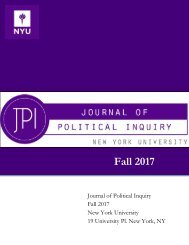JPI Spring 2018
Create successful ePaper yourself
Turn your PDF publications into a flip-book with our unique Google optimized e-Paper software.
THE “LOSS” OF CHINA: DISRUPTION OF U.S. STRATEGY AND NOSTALGIA FOR<br />
SINO-U.S. FRIENDSHIP<br />
By generalizing China as a communist enemy during this period, people usually ignore a<br />
significant element of the historical American attitude towards China which was the “loss” of China.<br />
Isaacs defines the “loss” of China (or, more accurately, the loss of the Nationalist Republic of China<br />
when they were overthrown by the PRC in 1949) as “a loss of self-confidence, a loss of assurance<br />
about security and power…a loss of certainty about the shape of the world and America’s place in it,<br />
perhaps the loss of the hope and expectation that they could return to their private world…and be<br />
free without fear or concern to enjoy it.” 8 He continues to argue that the Korean War consolidated<br />
the “loss” of China because the United States was forced to fight against the Chinese army on the<br />
Korean peninsula. 9 Thus, the “loss” of China should be considered a significant factor in the American<br />
perception of China after 1949.<br />
China was not only an ally during World War II and an important force in fighting the Japanese<br />
it was a key piece of America’s global strategy before 1949. The loss of China interrupted the United<br />
States’ plans for Asia and the Chinese could no longer act as an American ally to impede the spread<br />
of Communism. Prior to 1949, Americans believed that they were, “benevolent guardians and<br />
benefactors of China and the Chinese, as saviors, teachers, healers, protectors.” 10 With missionary<br />
efforts, trade, and military cooperation, the U.S. believed China would become modernized through<br />
American efforts. In fact, the United States felt it had a special responsibility to cultivate China. “At<br />
the end of 119 years of Protestant missionary work in China, there were said to be somewhere between<br />
half a million and a million Chinese Protestants.” 11 When the Nationalist Party was in danger of defeat<br />
in 1948, the Truman administration passed the China Aid Act to provide $125 million to support<br />
China. 12 However, all of America’s efforts were in vain after the victory of the Communist Party.<br />
People graduating from American educational institutions established in China began to work in a<br />
communist government. 13 All the achievements realized and resources contributed to China’s success<br />
now fell to the hands of the Communist regime.<br />
In addition to this frustration, the “loss” of China also disrupted American strategic planning<br />
in Asia after WWII. The Truman administration thought that “peace in the Pacific would depend on<br />
the replacement of Japan by a unified, democratic, and peaceful China.” 14 Furthermore, American<br />
officials believed that “China offered the only real post-war market for American manufactured<br />
goods.” 15 China, as an American ally in Asia, could aid in stabilizing regional politics and help the area<br />
resist the influence of the Soviet Union. However, communist China interrupted the American vision<br />
of post-war Asia. The Nationalist Party, which was supported by the United States, left mainland<br />
China and went to Taiwan after the victory of the PRC in 1949.<br />
To make matters worse, the unexpected friendship between China and the U.S.S.R. completely<br />
ended any American hopes for friendly relations with China. Even for Stalin, a Sino-Soviet communist<br />
alliance was unpredicted to some extent. When Mao visited Moscow in 1949, Stalin was, “uncertain<br />
about the long-term viability of a communist leadership in Beijing, [and] aimed at getting a treaty that<br />
8<br />
Harold Isaacs, Scratches on Our Minds: American Views of China and India (New York: M.E. Sharpe, 1980), 191.<br />
9<br />
Harold Isaacs, Scratches on Our Minds: American Views of China and India (New York: M.E. Sharpe, 1980), 191.<br />
10<br />
Harold Isaacs, Scratches on Our Minds: American Views of China and India (New York: M.E. Sharpe, 1980), 193.<br />
11<br />
Harold Isaacs, Scratches on Our Minds: American Views of China and India (New York: M.E. Sharpe, 1980), 206.<br />
12<br />
Robert Sutter, US-Chinese Relations Perilous Past, Pragmatic Present (Lanham: Rowman & Littlefield, 2010), 50.<br />
13<br />
Harold Isaacs, Scratches on Our Minds: American Views of China and India (New York: M.E. Sharpe, 1980), 207.<br />
14<br />
Akira Iriye, Across the Pacific: An Inner History of American-East Asian Relations (Chicago: Imprint Publications, 1992), 254.<br />
15<br />
John Dower, War Without Mercy: Race and Power in the Pacific War (New York: Pantheon Books, 1986), 171.<br />
<strong>JPI</strong> Fall 2017, pg. 50
















